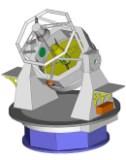The envelope of Betelgeuse in 2019-2020
Betelgeuse is one of most prominent semiregular variable stars in the sky. The nature of its variability is related to convection and pulsations typical for a red supergiant star. In 2019-2020 Betelgeuse showed an unusually deep minumum which attracted a lot of attention. In particular this minimum may prove useful as a test case for the modern models of stellar atmospheres of evolved stars.
We made observations of the star on 17 dates covering the period of the deep minimum of 2019-2020 using differential speckle polarimetry - the method for recovery of information about polarized flux distribution at diffraction limited resolution. In our experiment resolution amounted to 0.05 arcsec which allowed to resolve the base of dusty stellar wind. The results of these observations are presented in a preprint.
The animation to the right was obtained by the pixel-wise interpolation of individual reconstructed images of the object in absolute polarized intensity (arbitrary units) on a equidistant temporal grid. The wavelegth is 550 nm. In the lower panel an AAVSO lightcurve is presented. Black dots are individual AAVSO V band measurements. Red line is a smoothed lightcurve. Empty red circles indicate date of speckle polarimetric observations. Running filled red circle indicate the date for a current image in the upper panel.
The animation demonstrates the inhomogeneous dusty innermost atmosphere of Betelgeuse. The envelope features are likely to be due to emerging and disappering dust clouds above convection cells in the star below. One of such clouds, an unusally massive one, probably caused dimming of winter 2019-2020. Judging by the animation this cloud obscured preferentially southern part of the star, which was reported before by Montarges et al. It is interesting that after the recovery of the star from minimum southern part of the envelope became brighter than the other parts. This indicates that dust content in this part of the envelope increased.
|



